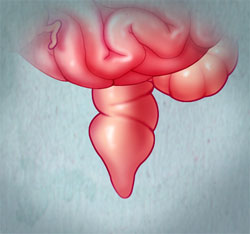 People often link rectal bleeding with cancer even though it can also be the result of any of several non-cancerous conditions. It is always a sign that something is wrong. If you experience this type of bleeding, it is important to check with your physician to identify its specific cause and start appropriate treatment.
People often link rectal bleeding with cancer even though it can also be the result of any of several non-cancerous conditions. It is always a sign that something is wrong. If you experience this type of bleeding, it is important to check with your physician to identify its specific cause and start appropriate treatment.
FAQs
Any bleeding should be taken seriously. Be sure to call your physician.
The main causes of rectal bleeding are:
Hemorrhoids — These are dilated blood vessels or veins in the anal or rectal area. They can occur on the outside where they are felt as small bumps when wiping; or they may be on the inside where they are usually painless. They are quite common and are associated with chronic constipation, increased perirectal pressure and with pregnancy.
Fistulas — A fistula is an abnormal channel that usually runs from the rectum to the skin around the anus. It often will drain a white or pink colored discharge, but it can also bleed. While it is usually just a local problem, a fistula can be associated with chronic inflammation in other parts of the intestinal tract, such as Crohn’s disease.
Anal fissures — The passage of a hard stool and straining or severe diarrhea may tear the lining tissue of the anus. Nerve endings and blood vessels are exposed so that pain and bleeding may occur with bowel movements.
Diverticulosis — Diverticula are pockets or sacs that project from the bowel wall. They balloon out over the years due to recurrent, high-pressure spasms in the colon and lack of fiber in the diet. When they do occasionally bleed, they can produce a large amount of blood.
Proctitis and Colitis — Either the rectum, colon or both can become inflamed and ulcerated. This can be accompanied by rectal urgency, cramps or diarrhea associated with the bleeding. When the inflammation is restricted to the rectum, the condition is call proctitis. When the colon is involved, it is called colitis. It is important to identify the specific cause of the inflammation so that appropriate
treatment can be started.
Polyps and Cancer – Polyps are benign growths in the colon. When polyps, which can be associated with colon cancer, reach a large size they can bleed intermittently which can be microscopic or occult bleeding.
Protrusion or prolapse of the Rectum – Some older people will have weakened rectal support tissues. Part of the rectum then can project from the anus and bleed. It can be felt as an abnormal bulging from the rectum when wiping.
There are four ways your doctor typically can identify the cause:
Your medical history
A visual and digital exam with anoscopy— Your physician will inspect the anal area looking for tears and hemorrhoids. A finger exam can provide information when there is tenderness or a tumor inside. In men, the prostate is also examined.
Endoscopy — There are several types of endoscopes used to view the colon. In the office, the physician may perform an exam called flexible sigmoidoscopy or anoscopy. A more thorough exam is accomplished with a colonoscope, allowing the physician to view the entire five- to six-foot long colon. Sedation is usually given for this exam.
Barium enema x-ray — Liquid barium is inserted by enema into the rectum. X-rays will then highlight abnormal shadows, such as tumors, diverticuli, and colitis.
Treatments depend on the specific cause of the bleeding. They can range from simple over-the-counter and at-home remedies to prescription medicines and surgery.